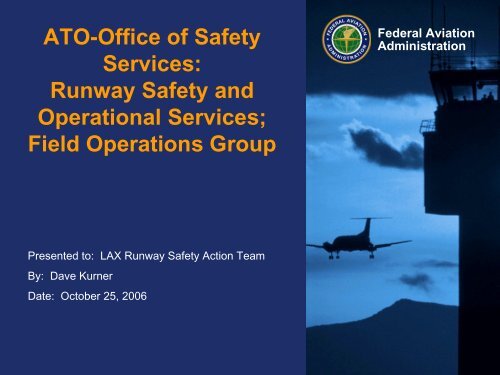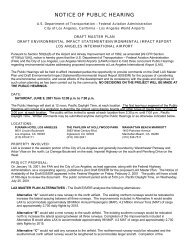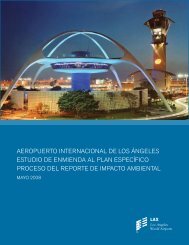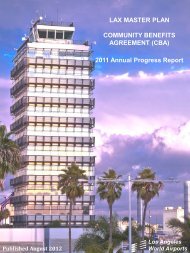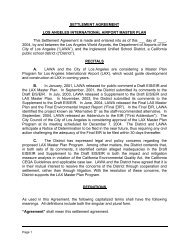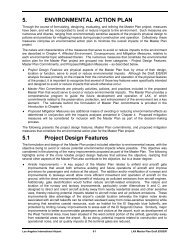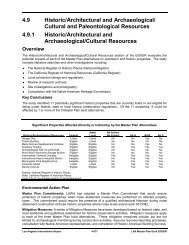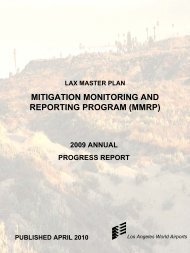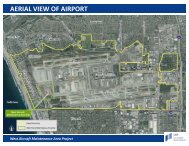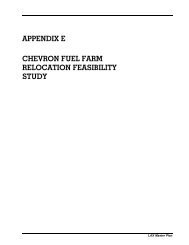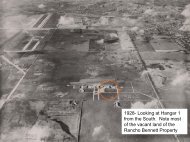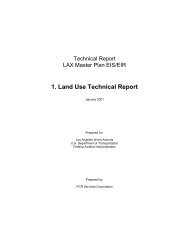ATO-Office of Safety Services: Runway Safety ... - LAX Master Plan
ATO-Office of Safety Services: Runway Safety ... - LAX Master Plan
ATO-Office of Safety Services: Runway Safety ... - LAX Master Plan
You also want an ePaper? Increase the reach of your titles
YUMPU automatically turns print PDFs into web optimized ePapers that Google loves.
<strong>ATO</strong>-<strong>Office</strong> <strong>of</strong> <strong>Safety</strong><br />
<strong>Services</strong>:<br />
<strong>Runway</strong> <strong>Safety</strong> and<br />
Operational <strong>Services</strong>;<br />
Field Operations Group<br />
Federal Aviation<br />
Administration<br />
Presented to: <strong>LAX</strong> <strong>Runway</strong> <strong>Safety</strong> Action Team<br />
By: Dave Kurner<br />
Date: October 25, 2006
• Definition Review<br />
OVERVIEW<br />
– Surface Incident - Classification by Cause<br />
– RI / Non-RI<br />
– Collision Risk Category<br />
• <strong>Runway</strong> <strong>Safety</strong> Trends<br />
• <strong>Runway</strong> <strong>Safety</strong> Action Team (RSAT)<br />
– WHAT is it? WHO is it? WHAT can it do Reduce the Risk<br />
<strong>of</strong> <strong>Runway</strong> Incursions<br />
• <strong>Runway</strong> <strong>Safety</strong> Action <strong>Plan</strong> (RSAP)<br />
– How to make it work for you<br />
– <strong>Runway</strong> <strong>Safety</strong> Action Items<br />
• Surface <strong>Safety</strong> System Dynamics<br />
<strong>ATO</strong>-<strong>Office</strong> <strong>of</strong> <strong>Safety</strong> <strong>Services</strong>: <strong>Runway</strong> <strong>Safety</strong> and Operational<br />
<strong>Services</strong>; Field Operation Group<br />
October 25, 2006<br />
Federal Aviation<br />
Administration<br />
2
SURFACE INCIDENT CATEGORIES<br />
PILOT DEVIATIONS – A Violation <strong>of</strong> Federal Air<br />
<strong>ATO</strong>-<strong>Office</strong> <strong>of</strong> <strong>Safety</strong> <strong>Services</strong>: <strong>Runway</strong> <strong>Safety</strong> and Operational<br />
<strong>Services</strong>; Field Operation Group<br />
October 25, 2006<br />
Regulations by a Pilot<br />
OPERATIONAL ERRORS/DEVIATIONS – The<br />
failure <strong>of</strong> an Air Traffic Controller to follow procedures<br />
resulting in a loss <strong>of</strong> separation or instructing an aircraft<br />
to take <strong>of</strong>f or land on a closed runway<br />
Any<br />
unauthorized entry to an Airport Movement Area by a<br />
Vehicle, Pedestrian, or Object or failure to follow<br />
procedures and/or Air Traffic instruction<br />
************************************************************<br />
VEHICLE/PEDESTRIAN DEVIATIONS – Any<br />
COLLISION RISK CATEGORIES<br />
A B C D<br />
Federal Aviation<br />
Administration<br />
3
<strong>ATO</strong>-<strong>Office</strong> <strong>of</strong> <strong>Safety</strong> <strong>Services</strong>: <strong>Runway</strong> <strong>Safety</strong> and Operational<br />
<strong>Services</strong>; Field Operation Group<br />
October 25, 2006<br />
Federal Aviation<br />
Administration<br />
4
Most Frequent <strong>Runway</strong> Incursion Errors<br />
• Operational Errors<br />
– Authorized aircraft to enter, cross, or hold on the runway then<br />
cleared an arrival or departure on the same runway<br />
32.7% <strong>of</strong> all OEs<br />
40.0% <strong>of</strong> all A & B OEs<br />
– Pilot Deviations<br />
• Pilot entered the runway after correct readback <strong>of</strong> a Hold Short<br />
instruction<br />
24.7% <strong>of</strong> all PDs<br />
23.1% <strong>of</strong> A & B PDs<br />
– Vehicle/Pedestrian Deviations<br />
– Vehicle or pedestrian entered runway without instruction.<br />
– Violator was NOT AUTHORIZED access to the airfield.<br />
35.3% <strong>of</strong> all V/PDs<br />
50.0% <strong>of</strong> A & B V/PDs<br />
<strong>ATO</strong>-<strong>Office</strong> <strong>of</strong> <strong>Safety</strong> <strong>Services</strong>: <strong>Runway</strong> <strong>Safety</strong> and Operational<br />
<strong>Services</strong>; Field Operation Group<br />
October 25, 2006<br />
Federal Aviation<br />
Administration<br />
5
<strong>Runway</strong> <strong>Safety</strong> Action Team &<br />
• Purpose<br />
(Local - RSAT)<br />
• Structure<br />
• Frequency <strong>of</strong> Meetings<br />
(LRSAT)<br />
<strong>ATO</strong>-<strong>Office</strong> <strong>of</strong> <strong>Safety</strong> <strong>Services</strong>: <strong>Runway</strong> <strong>Safety</strong> and Operational<br />
<strong>Services</strong>; Field Operation Group<br />
October 25, 2006<br />
Federal Aviation<br />
Administration<br />
6
RSAT – Purpose/Structure<br />
• Assemble and coordinate a team <strong>of</strong> skilled<br />
aviation pr<strong>of</strong>essionals with demonstrated<br />
expertise– Pilots, Air Traffic Controllers and<br />
Specialists, Flight Standards Inspectors, Airport<br />
Certification and <strong>Safety</strong> Inspectors, Airport<br />
Engineers, Funding and Compliance Specialists,<br />
Air Traffic Technical <strong>Services</strong> personnel and<br />
others as necessary to combine their skills and<br />
experience to consolidate recommendations that<br />
improve surface safety and reduce the risk <strong>of</strong><br />
runway incursions into Action Items forming a<br />
<strong>Runway</strong> <strong>Safety</strong> Action <strong>Plan</strong> (RSAP).<br />
<strong>ATO</strong>-<strong>Office</strong> <strong>of</strong> <strong>Safety</strong> <strong>Services</strong>: <strong>Runway</strong> <strong>Safety</strong> and Operational<br />
<strong>Services</strong>; Field Operation Group<br />
October 25, 2006<br />
Federal Aviation<br />
Administration<br />
7
RSAT – <strong>Safety</strong> Visits<br />
• Standard RSAT<br />
<strong>ATO</strong>-<strong>Office</strong> <strong>of</strong> <strong>Safety</strong> <strong>Services</strong>: <strong>Runway</strong> <strong>Safety</strong> and Operational<br />
<strong>Services</strong>; Field Operation Group<br />
October 25, 2006<br />
– Usually two days (adaptable to circumstance)<br />
– Day one: In-Briefing with Airport and Air Traffic<br />
• Prior to In-Brief walk-around around landside <strong>of</strong> Airport observing<br />
access-control; control; talk with Flight School and FBO Chief Pilots,<br />
FBO Managers, Maintenance Operations, observe flight and<br />
surface operations, and talk with Pilots and other users. If<br />
flying in commercial – talk with crew about airport and air<br />
traffic operations and/or difficulties. Invite all to User Group<br />
Meeting.<br />
• Conduct In-Brief (1-2 2 hours) explaining the RSAT process,<br />
RSAP development, advantages <strong>of</strong> RSAP to Airport, Air<br />
Traffic, Users, etc.<br />
• Conduct Airport ride around (movement area) and ATCT<br />
observation/information gathering – Day and Night.<br />
• Conduct User Group meeting in conjunction with Airport and<br />
Air Traffic.<br />
Federal Aviation<br />
Administration<br />
8
• Day Two:<br />
RSAT – <strong>Safety</strong> Visits<br />
– Conduct Team meeting – outline proposed action items<br />
for RSAP development. (FAA only – to resolve individual<br />
differences/observances)<br />
– Conduct <strong>Runway</strong> <strong>Safety</strong> Action <strong>Plan</strong> meeting. Action<br />
Items, ECDs, , and Responsible Party will be discussed<br />
with full RSAT Team (including airport authority,<br />
operations, ATCT, State Aviation Authority, Consultants,<br />
etc.) - All Action Items will be specifically oriented to<br />
improving the Surface <strong>Safety</strong> <strong>of</strong> the airport, operation,<br />
facility.<br />
– CONCURRENCE <strong>of</strong> group is ESSENTIAL !!<br />
– Discuss the draft plan with the users that attend the<br />
second (public) portion <strong>of</strong> the meeting and solicit their<br />
input – make sure they understand the part they play in<br />
success.<br />
<strong>ATO</strong>-<strong>Office</strong> <strong>of</strong> <strong>Safety</strong> <strong>Services</strong>: <strong>Runway</strong> <strong>Safety</strong> and Operational<br />
<strong>Services</strong>; Field Operation Group<br />
October 25, 2006<br />
Federal Aviation<br />
Administration<br />
9
RSAP<br />
<strong>Runway</strong> <strong>Safety</strong> Action <strong>Plan</strong><br />
• A Surface <strong>Safety</strong> <strong>Plan</strong> developed by the FAA, the<br />
State, Airport Authority, Airport Operations, and<br />
the Tenants, Users and Pilots. CONSENSUS<br />
• The RSAP is the FOCUS and OBJECTIVE <strong>of</strong> the<br />
RSAT and LRSAT, and must be reviewed, revised,<br />
and evaluated for effectiveness on a regular basis<br />
to continuously recognize and correct surface<br />
safety issues BEFORE they become Surface<br />
Incidents – THUS “REDUCING THE RISK OF<br />
RUNWAY INCURSIONS”<br />
<strong>ATO</strong>-<strong>Office</strong> <strong>of</strong> <strong>Safety</strong> <strong>Services</strong>: <strong>Runway</strong> <strong>Safety</strong> and Operational<br />
<strong>Services</strong>; Field Operation Group<br />
October 25, 2006<br />
Federal Aviation<br />
Administration<br />
10
RSAP Draft<br />
• The RSAT will result in the Draft RSAP. The Draft<br />
RSAP will be circulated among all LOBs in the Region<br />
for review and input regarding Regulatory<br />
Compliance, Funding Availability, Policy and other<br />
concerns<br />
• The Draft RSAT is in the Region for 30-45 days and<br />
then is distributed to the Local RSAT members for<br />
review and comment. After 60 days the RSAP<br />
becomes Final, and is entered into the DMRS Data<br />
Base. Throughout the process “silence is considered<br />
consent”.<br />
• The RSAP is tracked and ECDs are monitored for<br />
completion or closure.<br />
<strong>ATO</strong>-<strong>Office</strong> <strong>of</strong> <strong>Safety</strong> <strong>Services</strong>: <strong>Runway</strong> <strong>Safety</strong> and Operational<br />
<strong>Services</strong>; Field Operation Group<br />
October 25, 2006<br />
Federal Aviation<br />
Administration<br />
11
<strong>Runway</strong> <strong>Safety</strong> Action <strong>Plan</strong><br />
(RSAP)<br />
• Recommended revisions <strong>of</strong> the original or<br />
modified action item is redistributed to<br />
originator(s) for concurrence<br />
• Upon completion <strong>of</strong> the draft process the<br />
RSAP is entered into the national RSAP<br />
database<br />
• <strong>ATO</strong> <strong>Safety</strong> and AWP-1R track the item<br />
<strong>ATO</strong>-<strong>Office</strong> <strong>of</strong> <strong>Safety</strong> <strong>Services</strong>: <strong>Runway</strong> <strong>Safety</strong> and Operational<br />
<strong>Services</strong>; Field Operation Group<br />
October 25, 2006<br />
Federal Aviation<br />
Administration<br />
12
Direct Pilot Notification<br />
• <strong>Runway</strong> Status Lights – ADS-B – ASDE-X –<br />
Honeywell Ground Movement System<br />
• FAROS – Final Approach <strong>Runway</strong> Occupancy<br />
Signal – Flashing PAPIs<br />
• ERGLs - Elevated <strong>Runway</strong> Guard Lights and<br />
Sequenced In-Pavement <strong>Runway</strong> Guard Lights -<br />
Surface Painted Signs<br />
• Enhanced <strong>Runway</strong> Holding Position Markings –<br />
Enhanced Taxiway Centerlines<br />
• Improvements/changes in Airport Geometry<br />
• USE <strong>of</strong> Aircraft Landing Light to indicate<br />
movement on <strong>Runway</strong><br />
<strong>ATO</strong>-<strong>Office</strong> <strong>of</strong> <strong>Safety</strong> <strong>Services</strong>: <strong>Runway</strong> <strong>Safety</strong> and Operational<br />
<strong>Services</strong>; Field Operation Group<br />
October 25, 2006<br />
Federal Aviation<br />
Administration<br />
13
Aviation <strong>Safety</strong> System<br />
Interdependence<br />
• Continuous Emphasis <strong>of</strong> Responsibility to recognize<br />
errors and correct those errors before they progress to<br />
Incidents or Accidents (Reduce the Risk <strong>of</strong> <strong>Runway</strong><br />
Incursions – FAA Flight <strong>Plan</strong> Goal) by:<br />
– Airport Traffic Control Tower<br />
– Pilots<br />
– Airport Operations – Airport Design and Layout<br />
– Vehicle Drivers and Pedestrians who use or have access to<br />
the Airport Movement Area<br />
– Emergency Responders<br />
• Error in any one <strong>of</strong> these groups must be recognized<br />
and mitigated either by the person committing the error<br />
or someone in one or more <strong>of</strong> the other groups<br />
<strong>ATO</strong>-<strong>Office</strong> <strong>of</strong> <strong>Safety</strong> <strong>Services</strong>: <strong>Runway</strong> <strong>Safety</strong> and Operational<br />
<strong>Services</strong>; Field Operation Group<br />
October 25, 2006<br />
Federal Aviation<br />
Administration<br />
14
Lack <strong>of</strong> Situational Awareness<br />
Pilots – Pilot entered <strong>Runway</strong> AFTER making a correct<br />
readback <strong>of</strong> a Hold Short instruction:<br />
• 24.7% <strong>of</strong> ALL Pilot Deviation <strong>Runway</strong> Incursions<br />
• 40.0% <strong>of</strong> A & B PD RIs<br />
• Failing to hold short<br />
• Disoriented – using wrong runway or taxiway<br />
• Frequency Awareness<br />
• Read backs<br />
• Surveillance – Mk 1 Mod 0 EYEBALLS – outside vs.<br />
checklists/flight director setup/radios/transponders<br />
<strong>ATO</strong>-<strong>Office</strong> <strong>of</strong> <strong>Safety</strong> <strong>Services</strong>: <strong>Runway</strong> <strong>Safety</strong> and Operational<br />
<strong>Services</strong>; Field Operation Group<br />
October 25, 2006<br />
Federal Aviation<br />
Administration<br />
15
Direct Pilot Notification<br />
• Use <strong>of</strong> Exterior Aircraft Lights to make aircraft more<br />
conspicuous:)Take<strong>of</strong>f:<br />
Turn on Landing Lights when<br />
take<strong>of</strong>f clearance is received , or when commencing<br />
take<strong>of</strong>f roll at an airport without an operating tower.<br />
Note: The SOP <strong>of</strong> turning on landing lights when<br />
take<strong>of</strong>f clearance is received is a signal to other<br />
pilots, ATC, and ground personnel that the aircraft is<br />
moving down the runway for take<strong>of</strong>f.<br />
<strong>ATO</strong>-<strong>Office</strong> <strong>of</strong> <strong>Safety</strong> <strong>Services</strong>: <strong>Runway</strong> <strong>Safety</strong> and Operational<br />
<strong>Services</strong>; Field Operation Group<br />
October 25, 2006<br />
Federal Aviation<br />
Administration<br />
16
Surface Incident Mitigated by Landing<br />
Light Usage<br />
• B737 -11 landed R/W 24R and was instructed to “exit at<br />
the forward, cross R/W 24L, traffic (B737-2) in position.<br />
Contact Ground point 65”. . AMASS alerted, controller<br />
sent an air carrier aircraft making S-Turns S<br />
on final<br />
around. B737-1 1 heard go-around, and observed<br />
Landing Lights at approach end <strong>of</strong> R/W 24L, , and<br />
stopped. B737-1 1 questioned crossing instructions and<br />
was told to “stand-by” on second attempt. Tower had<br />
cleared TIPH (B737-2) traffic for take<strong>of</strong>f R/W 24L.<br />
B737-1 1 holding short R/W 24L had crossed hold line<br />
via T/W Z, but did not enter R/W 24L. B737-2 2 rotated<br />
1,000 feet prior to T/W Z and passed T/W Z at 200 feet<br />
vertical.<br />
Operational Error <strong>Runway</strong> Incursion Risk Cat. D<br />
<strong>ATO</strong>-<strong>Office</strong> <strong>of</strong> <strong>Safety</strong> <strong>Services</strong>: <strong>Runway</strong> <strong>Safety</strong> and Operational<br />
<strong>Services</strong>; Field Operation Group<br />
October 25, 2006<br />
Federal Aviation<br />
Administration<br />
17
SURFACE SAFETY<br />
CONSIDERATIONS<br />
Airport Design/Layout<br />
EuroControl<br />
<strong>Runway</strong> <strong>Safety</strong> Workshop –<br />
AIRPORT DESIGN was First Focal Area<br />
Complex and varying Airport Geometry<br />
As Air Traffic grows, the risk <strong>of</strong> runway<br />
accidents will grow<br />
There must be commensurate growth and<br />
development <strong>of</strong> airport infrastructures<br />
<strong>ATO</strong>-<strong>Office</strong> <strong>of</strong> <strong>Safety</strong> <strong>Services</strong>: <strong>Runway</strong> <strong>Safety</strong> and Operational<br />
<strong>Services</strong>; Field Operation Group<br />
October 25, 2006<br />
Federal Aviation<br />
Administration<br />
18
AIRPORT DESIGN<br />
• Older airport designs vs. Larger, Faster,<br />
Heavier Aircraft<br />
• Effects <strong>of</strong> higher Operations Tempos<br />
• Center Taxiways between parallel runways<br />
• Greater centerline to centerline distance<br />
between parallel runways<br />
• Greater situational awareness for pilots<br />
provided by better layout<br />
• 75% <strong>of</strong> <strong>LAX</strong> <strong>Runway</strong> Incursions are Pilot<br />
Dev<br />
<strong>ATO</strong>-<strong>Office</strong> <strong>of</strong> <strong>Safety</strong> <strong>Services</strong>: <strong>Runway</strong> <strong>Safety</strong> and Operational<br />
<strong>Services</strong>; Field Operation Group<br />
October 25, 2006<br />
Federal Aviation<br />
Administration<br />
19
<strong>ATO</strong>-<strong>Office</strong> <strong>of</strong> <strong>Safety</strong> <strong>Services</strong>: <strong>Runway</strong> <strong>Safety</strong> and Operational<br />
<strong>Services</strong>; Field Operation Group<br />
October 25, 2006<br />
Federal Aviation<br />
Administration<br />
20
<strong>ATO</strong>-<strong>Office</strong> <strong>of</strong> <strong>Safety</strong> <strong>Services</strong>: <strong>Runway</strong> <strong>Safety</strong> and Operational<br />
<strong>Services</strong>; Field Operation Group<br />
October 25, 2006<br />
Federal Aviation<br />
Administration<br />
21
<strong>ATO</strong>-<strong>Office</strong> <strong>of</strong> <strong>Safety</strong> <strong>Services</strong>: <strong>Runway</strong> <strong>Safety</strong> and Operational<br />
<strong>Services</strong>; Field Operation Group<br />
October 25, 2006<br />
Federal Aviation<br />
Administration<br />
22
RESPONSIBILITIES<br />
• “The<br />
best people can make the worst mistakes:<br />
INATTENTION,<br />
FORGETFULNESS,<br />
PREOCCUPATION,<br />
…are the LEAST manageable parts <strong>of</strong> the error<br />
sequence.<br />
Managing ERROR PRODUCING SITUATIONS is<br />
better”<br />
Dr. James Reason, Manchester University, UK<br />
<strong>ATO</strong>-<strong>Office</strong> <strong>of</strong> <strong>Safety</strong> <strong>Services</strong>: <strong>Runway</strong> <strong>Safety</strong> and Operational<br />
<strong>Services</strong>; Field Operation Group<br />
October 25, 2006<br />
Federal Aviation<br />
Administration<br />
23
RESPONSIBILITIES<br />
• BOYD’S S and DITTO’S<br />
METHOD:<br />
OODA LOOP<br />
»OBSERVE<br />
»DECIDE<br />
»ACT<br />
»ORIENT<br />
<strong>ATO</strong>-<strong>Office</strong> <strong>of</strong> <strong>Safety</strong> <strong>Services</strong>: <strong>Runway</strong> <strong>Safety</strong> and Operational<br />
<strong>Services</strong>; Field Operation Group<br />
October 25, 2006<br />
Federal Aviation<br />
Administration<br />
24
RESPONSIBILITIES<br />
“THE<br />
PILOT IS THE<br />
WHOLE AVIATION<br />
SAFETY’S S GOALKEEPER”<br />
Capt. Dan Maurino, ICAO Flight <strong>Safety</strong><br />
<strong>ATO</strong>-<strong>Office</strong> <strong>of</strong> <strong>Safety</strong> <strong>Services</strong>: <strong>Runway</strong> <strong>Safety</strong> and Operational<br />
<strong>Services</strong>; Field Operation Group<br />
October 25, 2006<br />
Federal Aviation<br />
Administration<br />
25
www.ato.faa.gov<br />
<strong>ATO</strong>-<strong>Office</strong> <strong>of</strong> <strong>Safety</strong> <strong>Services</strong>: <strong>Runway</strong> <strong>Safety</strong> and Operational<br />
<strong>Services</strong>; Field Operation Group<br />
October 25, 2006<br />
Federal Aviation<br />
Administration<br />
26


